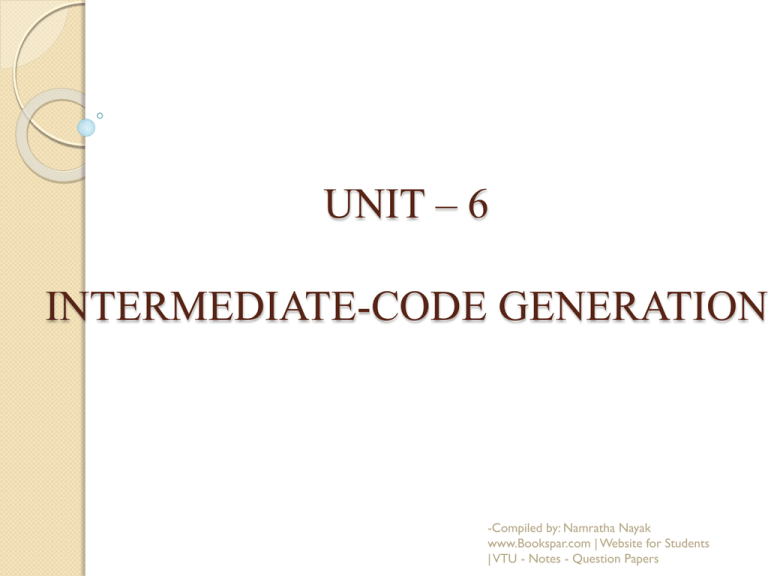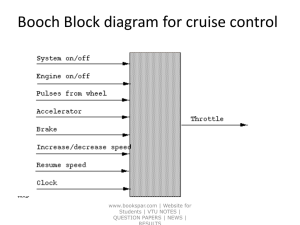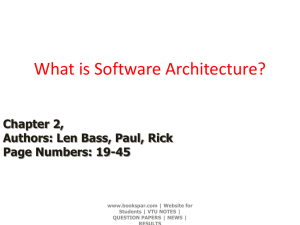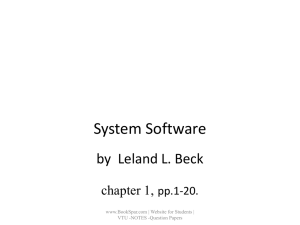CD-Unit-6-Intermediate-Code-Generation-by-Namratha
advertisement

UNIT – 6 INTERMEDIATE-CODE GENERATION -Compiled by: Namratha Nayak www.Bookspar.com | Website for Students | VTU - Notes - Question Papers Introduction In the analysis-synthesis model of a compiler ◦ The front end analyzes a source program and creates an intermediate representation ◦ The back end generates target code using the intermediate representation ◦ Details of source language are confined to front end and details of target machine to the back end ◦ A compiler for language i and machine j can be built by combining the front end for the language i with back end for machine j -Compiled by: Namratha Nayak www.Bookspar.com | Website for Students | VTU - Notes - Question Papers Introduction Static type checking includes type checking, which ensures that operators are applied to compatible operands ◦ Also includes any syntactic checks that remain after parsing ◦ Example: static checking assures that a break statement is enclosed within a while-, for-, or switch-statement In the process of translating a program into code for the given target machine, a compiler may construct a sequence of intermediate representations -Compiled by: Namratha Nayak www.Bookspar.com | Website for Students | VTU - Notes - Question Papers Introduction Syntax trees are high level; they depict the hierarchical structure of the source program Low-level representation is suitable for machine-dependent tasks like register allocation and instruction selection ◦ Three-address code can range from high to low level depending on the choice of operators ◦ For looping statements, a syntax tree represents components of a statement, whereas three-address code contains labels and jump instructions to represent the flow of control Choice of an intermediate representation varies from compiler to compiler -Compiled by: Namratha Nayak www.Bookspar.com | Website for Students | VTU - Notes - Question Papers Variants of Syntax Trees Nodes in syntax tree represent constructs in the source program; the children of a node represent components of a construct A directed acyclic graph (DAG) for an expression identifies the common subexpressions of the expression ◦ Common subexpressions are those subexpressions that occur more than once DAG’s can be constructed using the same techniques that construct syntax trees Discuss about ◦ DAG’s for expressions ◦ Value-number method for constructing DAG’s -Compiled by: Namratha Nayak www.Bookspar.com | Website for Students | VTU - Notes - Question Papers Directed Acyclic Graphs for Expressions Like a syntax tree, a DAG has leaves corresponding to atomic operands and interior nodes corresponding to operators ◦ The difference is that a node N in a DAG has more than one parent if N represents a common subexpression ◦ In a syntax tree, the tree for common subexpression would be replicated as many times as it appears in the original expression Thus, a DAG not only represents expressions, but gives the compiler important clues regarding the generation of efficient code to evaluate expressions -Compiled by: Namratha Nayak www.Bookspar.com | Website for Students | VTU - Notes - Question Papers Directed Acyclic Graphs for Expressions DAG for the expression a + a * (b – c) + (b – c) * d -Compiled by: Namratha Nayak www.Bookspar.com | Website for Students | VTU - Notes - Question Papers Directed Acyclic Graphs for Expressions SDD to construct either syntax trees or DAG’s It will construct a DAG if, before creating a new node, these functions check whether an identical node already exists ◦ If a previously created identical node exists, the existing node is returned, else it creates a new node -Compiled by: Namratha Nayak www.Bookspar.com | Website for Students | VTU - Notes - Question Papers Directed Acyclic Graphs for Expressions Steps for constructing the DAG for the expression : a + a * (b – c) + (b – c) * d -Compiled by: Namratha Nayak www.Bookspar.com | Website for Students | VTU - Notes - Question Papers The Value-Number Method for Constructing DAG’s The nodes of a syntax tree or DAG are stored in an array of records ◦ Each row of the array represents one record, and therefore one node ◦ In each record, the first field is an operation code, indicating the label of the node ◦ The leaves have one additional field, which holds the lexical value ◦ Interior node have two additional children indicating the left and right children -Compiled by: Namratha Nayak www.Bookspar.com | Website for Students | VTU - Notes - Question Papers The Value-Number Method for Constructing DAG’s In this array, we refer to nodes by giving the integer index of the record for that node within the array ◦ This integer is called the value number for the node or for the expression represented by the node ◦ If store in appropriate data structures, value numbers help us construct expression DAG’s efficiently Suppose that nodes are stored in an array, and each node is referred to by its value number ◦ Let the signature of an interior node be the triple op, l , r , where op is the label, l its left child’s value number, and r its right child’s value number ◦ A unary operator may be assumed to have r = 0 -Compiled by: Namratha Nayak www.Bookspar.com | Website for Students | VTU - Notes - Question Papers The Value-Number Method for Constructing DAG’s -Compiled by: Namratha Nayak www.Bookspar.com | Website for Students | VTU - Notes - Question Papers The Value-Number Method for Constructing DAG’s Searching the entire array to locate one node every time is expensive, if the array holds expressions from the entire program An efficient approach is to use a hash table, in which the nodes are put into “buckets”, each of which will have only a few nodes ◦ The hash table is one of the data structures that support dictionaries efficiently ◦ A dictionary is an abstract data type that allows us to insert and delete elements of a set, and determine whether a given element is currently in the set To construct hash table for the nodes of a DAG, ◦ we need a hash function h that computes the index of the bucket for a signature op, l, r , in a way that distributes the signatures across buckets ◦ The bucket index h(op, l, r) is computed deterministically from op, l, and r, so that we may repeat the calculation and always get to the same bucket index for node op, l, r -Compiled by: Namratha Nayak www.Bookspar.com | Website for Students | VTU - Notes - Question Papers The Value-Number Method for Constructing DAG’s The buckets can be implemented as linked lists ◦ An array, indexed by hash value, holds the bucket headers, each of which points to the first cell of a list ◦ Within the linked list for a bucket, each cell holds the value number of one of the nodes that hash to that bucket ◦ That is, node op, l , r can be found on the list whose header is at index h(op, l, r) of the array -Compiled by: Namratha Nayak www.Bookspar.com | Website for Students | VTU - Notes - Question Papers The Value-Number Method for Constructing DAG’s Given the input node op, l, and r, we compute the bucket index h(op, l, r) and search the list if cells in this bucket for the given input node We may need to look at all the cells within a bucket, ◦ And for each value number v found in a cell, we must check whether the signature op, l , r of the input node matches the node with the value number v in the list of cells ◦ If we find a match, we return v ◦ If we find no match, we know no such node can exist in any other bucket So we create a new cell, add it to the list of cells for bucket index h(op, l, r) , and return the value number in that new cell -Compiled by: Namratha Nayak www.Bookspar.com | Website for Students | VTU - Notes - Question Papers Three-Address Code There is at most one operator on the right side of an instruction ◦ Thus, a source-language expression like x+y*z might be translated into the sequence ◦ Here t1 and t2 are compiler-generated temporary names ◦ Use of names for the intermediate values computed by a program allows three-address code to be rearranged easily DAG and its corresponding three-address code -Compiled by: Namratha Nayak www.Bookspar.com | Website for Students | VTU - Notes - Question Papers Addresses and Instructions Three-address code is built from two concepts : addresses and instructions ◦ In OO terms, these concepts correspond to classes, and the various kinds of addresses and instructions correspond to appropriate subclasses An address can be one of the following ◦ Name : Allow source-program names to appear as addresses In implementation, source name is replaced by a pointer to its symbol-table entry ◦ Constant ◦ A compiler-generated temporary Symbolic labels are used by instructions that alter the flow of control ◦ It represents the index of a 3-address instruction in a sequence of instructions -Compiled by: Namratha Nayak www.Bookspar.com | Website for Students | VTU - Notes - Question Papers Addresses and Instructions Common three-address instruction forms ◦ Assignment instructions of the form , x = y op z ◦ Assignments of the form, x = op y, where op is a unary operation ◦ Copy instructions of the form, x = y ◦ An unconditional jump, goto L ◦ Conditional jumps of the form, if x goto L and if False x goto ◦ Conditional jumps such as, if x relop y goto L ◦ Indexed copy instructions of the form, x = y[i] and x[i] = y ◦ Address and pointer assignments of the form, x = &y, x = *y, and *x = y ◦ Procedure calls and returns implemented using the following instructions: param x - for parameters call p, n – procedure calls y = call p, n – function calls return y – representing a return value -Compiled by: Namratha Nayak www.Bookspar.com | Website for Students | VTU - Notes - Question Papers Addresses and Instructions Consider the statement do i = i + 1; while (a[i] < v); -Compiled by: Namratha Nayak www.Bookspar.com | Website for Students | VTU - Notes - Question Papers Quadruples In a compiler, 3-address instructions can be implemented as objects or as records with fields for operators and operands ◦ Quadruples, triples and indirect triples are such representations A quadruple has four fields : op, arg1, arg2 and result ◦ The op field contains an internal code for the operator ◦ The 3-address instruction x = y + z, is represented by placing + in op, y in arg1, z in arg2, and x in result Some exceptions to this rule ◦ Instructions with unary operators like x = minus y or x = y do not use arg2 ◦ Operators like param use neither arg2 nor result ◦ Conditional and unconditional jumps put the target label in result -Compiled by: Namratha Nayak www.Bookspar.com | Website for Students | VTU - Notes - Question Papers Quadruples Three-address code and its quadruple representation for the assignment a=b*-c+b*-c; -Compiled by: Namratha Nayak www.Bookspar.com | Website for Students | VTU - Notes - Question Papers Triples A triple has three fields : op, arg1, and arg2 ◦ The result field was used for temporary names ◦ Using triples, we refer to the result of an operation ,x op y by its position rather than a temporary name ◦ Instead of temporary t1, a triple representation would refer to position (0) ◦ Parenthesized numbers represent pointers into the triple structure itself Triples are equivalent to the signatures op, l , r ◦ So, DAG and triple representations of expressions are equivalent ◦ The equivalence ends with expressions, since control flow is different in syntax-tree and three-address code -Compiled by: Namratha Nayak www.Bookspar.com | Website for Students | VTU - Notes - Question Papers Triples Syntax-tree and its triple representation for the assignment a=b*-c+b*-c; -Compiled by: Namratha Nayak www.Bookspar.com | Website for Students | VTU - Notes - Question Papers Triples A ternary operation like x[i] = y requires two entries in the triple structure ◦ For example, put x and i in one triple and y in the next Similarly, x = y[i] can be treated as two instructions t = y[i] and x=t Benefit of quadruple over triples can be seen in an optimizing compiler, where instructions are often moved around ◦ With quadruples, if we move an instruction that computes a temporary t, then the instructions that use t require no change ◦ With triples, the result of an operation is referred to by its position, so moving an instruction may require us to change all references to that result -Compiled by: Namratha Nayak www.Bookspar.com | Website for Students | VTU - Notes - Question Papers Indirect Triples An optimizing compiler can move an instruction by reordering the instruction list, without affecting the triples themselves Indirect triples representation of the three-address code -Compiled by: Namratha Nayak www.Bookspar.com | Website for Students | VTU - Notes - Question Papers Static Single-Assignment Form (SSA) SSA is an intermediate representation that facilitates code optimizations Two distinctive aspects that distinguish SSA from 3-address code ◦ All assignments in SSA are to variables with distinct names, hence the term static single-assignment -Compiled by: Namratha Nayak www.Bookspar.com | Website for Students | VTU - Notes - Question Papers Static Single-Assignment Form (SSA) Same variable may be defined in two different control-flow paths ◦ If we use different names for x in the true part and false part then which name must be used in the assignment y = x * a ? ◦ SSA uses a notational convention called the Φ-function to combine the two definitions of x ◦ Here, Φ(x1, x2), has the value x1 if control flow passes through the true part and the value x2 if control flow passes through the false part of the conditional ◦ So, the Φ-function returns the value of its argument that corresponds to the control-flow path that was taken to get to the assignment statement containing the Φ-function -Compiled by: Namratha Nayak www.Bookspar.com | Website for Students | VTU - Notes - Question Papers Types and Declarations Type Checking ◦ Uses logical rules to reason about the behavior of a program at run time ◦ It ensures that types of the operands match the type expected by an operator ◦ For example, && operator expects its two operands to be boolean Translation applications ◦ From the type of name, compiler can determine the storage needed for that name at run time ◦ Type information is also needed to Calculate the address denoted by an array reference Insert explicit type conversions Choose the right version of an arithmetic operator Actual storage for a procedure call is allocated when the procedure is called at run time -Compiled Relative address of a name or component is by: anNamratha offsetNayak from the www.Bookspar.com | Website for Students start of the data area | VTU - Notes - Question Papers Type Expressions Types have structure that is represented using type expressions ◦ A type expression is Either a basic type Or formed by applying an operator called type constructor to a type expression ◦ The sets of basic types and constructors depend on the language Example : array type int[2][3] can be written as a type expression array(2,array(3,integer)) -Compiled by: Namratha Nayak www.Bookspar.com | Website for Students | VTU - Notes - Question Papers Type Expressions Use the following definition of type expressions ◦ Basic type is a type expression ◦ Type name is a type expression ◦ Type expression can be formed by applying the array type constructor to a number and a type expression ◦ A record is a data structure with named fields. A type expression can be formed by applying record type constructor to field names and their types ◦ A type expression can be formed by using the type constructor for function types. Can write s t for “function from type s to type t” ◦ If s and t are type expressions, then their Cartesian product , s x t, is a type expression ◦ Type expressions may contain variables whose values are type expressions -Compiled by: Namratha Nayak www.Bookspar.com | Website for Students | VTU - Notes - Question Papers Type Equivalence When are two type expressions equivalent? ◦ Many type-checking rules have the form, “if two type expressions are equal then return a certain type else error” ◦ Ambiguities arise when names are given to type expressions and the names are then used in subsequent type expressions ◦ Key issue us whether the name in a type expression stands for itself or whether it is an abbreviation for another type expression When type expressions are represented by graphs, the types are structurally equivalent if and only if one of the conditions is true ◦ They are the same basic type ◦ They are formed by applying the same constructor to structurally equivalent types ◦ One is a type name that denotes the other If type names stand for themselves, then the first two conditions -Compiled by: Namratha Nayak www.Bookspar.com | Website for Students lead to name equivalence of type expressions | VTU - Notes - Question Papers Declarations Grammar for types and declarations Deals with basic and array types ◦ Nonterminal D generates a sequence of declarations ◦ Nonterminal T generates basic, array , or record types ◦ Nonterminal B generates one of the basic types int and float ◦ Nonterminal C, for “component”, generates strings of zero or more integers, each integer surrounded by brackets ◦ An array type consists of a basic type B, followed by array components specified by C ◦ A record type is a sequence of declarations for fields of the record -Compiled by: Namratha Nayak www.Bookspar.com | Website for Students | VTU - Notes - Question Papers Storage Layout for Local Names Can determine the amount of storage needed for a name at run time from the type of the name ◦ At compile time, can use these amounts to assign each name a relative address ◦ The type and relative address are saved in the symbol-table entry for the name ◦ Data of varying length, such as dynamic arrays, is handled by reserving a fixed amount of storage for a pointer to the data Width of a type is the number of storage units needed for objects of that type ◦ A basic type such as character, integer or float require an integral number of bytes ◦ Aggregates like arrays and classes are allocated in one contiguous block of bytes for easy access -Compiled by: Namratha Nayak www.Bookspar.com | Website for Students | VTU - Notes - Question Papers Storage Layout for Local Names SDT for computing type and widths for basic and array types ◦ SDT uses type and width as synthesized attributes for each nonterminal ◦ Variables t and w are used to pas type and width information down the parse tree ◦ Width of an array is obtained by multiplying the width of an element by the -Compiled by: Namratha Nayak number of elements in the array www.Bookspar.com | Website for Students | VTU - Notes - Question Papers Storage Layout for Local Names Parse tree for the type int[2][3] is shown by dotted lines Solid edges show how the type and width are passed from B, down the chain of C’s through t and w, and then up the tree using type and width -Compiled by: Namratha Nayak www.Bookspar.com | Website for Students | VTU - Notes - Question Papers Sequences of Declarations C and Java allow all declarations in a single procedure to be processed as a group ◦ Can use a variable, say offset, to keep track of the next available relative address SDT for computing the relative addresses of declared names ◦ As each new name x is seen, x is entered into the symbol table with its relative address set to the current value of offset, which is then incremented by the width of the type x -Compiled by: Namratha Nayak www.Bookspar.com | Website for Students | VTU - Notes - Question Papers Sequences of Declarations The initialization of offset is more evident if the first production appears on one line as Nonterminals generating ε, called marker nonterminals, can be used to rewrite productions so that all actions appear at the ends of right sides ◦ Using a marker nonterminal M, the above production can be restated as : -Compiled by: Namratha Nayak www.Bookspar.com | Website for Students | VTU - Notes - Question Papers Fields in Records and Classes Record types can be added to a grammar by adding the following ◦ The fields in this record type are specified by the sequence of declarations generated by D ◦ The approach used in the previous section can be used to determine the types and relative addresses of fields, but need to be careful of two things Field names within a record must be distinct, that is, a name may appear at most once in the declarations generated by D The offset or relative address for a field name is relative to the data area for that record ◦ Example : Use of name x for a field within a record does not conflict with other uses of the name outside the record -Compiled by: Namratha Nayak www.Bookspar.com | Website for Students | VTU - Notes - Question Papers Fields in Records and Classes Record types encode both the types and relative addresses of their fields, using a symbol table for the record type ◦ A record type has the form record(t), where record is a type constructor, and t is a symbol-table object that holds information about the fields SDT for handling field names in records -Compiled by: Namratha Nayak www.Bookspar.com | Website for Students | VTU - Notes - Question Papers Translation of Expressions Issues that arise during the translation of expressions and statements Begin with the translation of expressions into three-address code ◦ An expression with more than one operator, like a+b*c, will translate into instructions with at most one operator per instruction ◦ An array reference A[i][j] will expand into a sequence of three-address instructions that calculate an address for the reference -Compiled by: Namratha Nayak www.Bookspar.com | Website for Students | VTU - Notes - Question Papers Operations Within Expressions SDD to build up the three-address code for expressions -Compiled by: Namratha Nayak www.Bookspar.com | Website for Students | VTU - Notes - Question Papers Incremental Translation Instead of building up the E.code, we can arrange to generate only the new three-address instructions as given in the SDT below : ◦ In incremental approach, gen not only constructs a three-address instruction, it appends the instruction to the sequence of instructions generated so far ◦ The sequence may either be retained in memory or output incrementally -Compiled by: Namratha Nayak www.Bookspar.com | Website for Students | VTU - Notes - Question Papers Addressing Array Elements Array elements can be accessed quickly if stored in a block of consecutive locations ◦ If width of each array element is w, then the ith element of array A begins at base i w (1.1) ◦ In two-dimensions, we write A[i1][i2] for element i2 in row i1 . Let w1 be the width of a row and w2 be the width of an element in a row. Relative address of A[i1][i2] can be calculated using: base i1 w1 i2 w2 (1.2) ◦ In k dimensions, the formula is base i1 w1 i2 w2 ..... ik wk (1.3) -Compiled by: Namratha Nayak www.Bookspar.com | Website for Students | VTU - Notes - Question Papers






